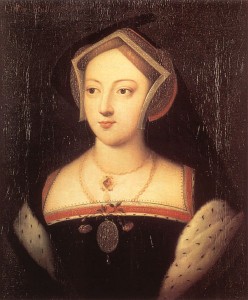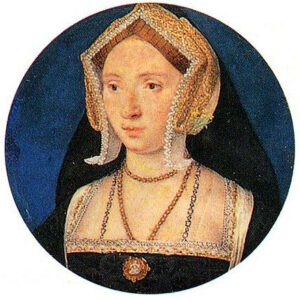
Following on from her previous posts on Mary Boleyn’s Birth and her childhood and education, Sarah Bryson considers Mary’s personality and appearance…
One of the most frustrating aspects when researching Mary Boleyn is the fact that there is not even an authenticated portrait of her. As with many people of the Tudor age there is no recorded description of what she looked like, no sketch or image for us to look upon today. In trying to work out what Mary Boleyn may have looked like we need to try and piece together the very scant evidence that surrounds her life.
Josephine Wilkinson who wrote ‘Mary Boleyn The True Story of Henry VIII’s Favourite Mistress’ states that “tradition has it that Mary Boleyn was the most beautiful of the Boleyn sisters. Even she, however, did not conform to the Tudor ideal of feminine beauty, which preferred pale skin, blue eyes and blonde hair. One portrait of Mary, although it is of doubtful authenticity [the Hever Castle portrait] shows her to have a rounder and softer face than that of her sister. Her complexion is creamy, her eyes brown and, although her hair is hidden beneath her gabled hood, its colour is suggested by the shade of her eyebrows, which hint at a rich auburn or a chestnut brown.” (Wilkinson p. 64).
The above image is the portrait from Hever Castle which Wilkinson is referring to. It is commonly believed to be a portrait of Mary Boleyn painted after the Holbein style. In the portrait we can see a woman with a slightly rounded face, wide deep brown eyes, lighter coloured skin and light brown eyebrows and perhaps matching colour hair.
In her latest book ‘Mary Boleyn: The Mistress of Kings’, Alison Weir agrees with Wilkinson that the above portrait is probably not an image of Mary Boleyn. Weir goes on to propose that the Hever Castle portrait is most likely to be Frances Brandon, oldest daughter of Mary Tudor and Charles Brandon, the Duke and Duchess of Suffolk. She states that when comparing known portraits of Charles Brandon and Mary Tudor with the above Hever Castle portrait many similarities can be seen, especially with the nose and chin. Weir also moves on to state that the clothing worn by the woman in the above portrait dates to approximately the 1530’s, a time when Mary Boleyn was no longer King Henry VIII’s mistress and had been banished from court. Hui, in his article ‘Two New Faces: The Hornebolte Portraits of Mary and Thomas Boleyn’ also states that the gable hood in the Hever Castle portrait dates to the mid 1530’s, again the time when Mary Boleyn would have been banished from court and therefore certainly would not have had portraits painted of her.

One of Horenbout’s most famous miniatures is of a woman believed to be Anne Boleyn, painted in about 1525/26. Initially the young woman in the portrait, whose age is given as twenty five years, was believed to be Anne Boleyn. Yet there is now some debate as to whether the woman in the portrait is actually Anne Boleyn. I propose that in fact it may be Mary Boleyn and not her sister Anne. Francesco Sanuto, a Venetian diplomat described Anne as ‘not one of the handsomest women in the world; she is of middling stature, swarthy complexion, long neck, wide mouth, a bosom not much raised and eyes which are black and beautiful’ (Ives 2005, p. 40).
In her book The Lady in the Tower, Alison Weir also describes Anne as being ‘slender and dark’ (Weir 2009, p. 160), whereas the woman in the Horenbout portrait appears to have a much rounder face and has a pale complexion with perhaps light brown eyebrows and possibly the same coloured hair.
Alison Weir, in her book ‘Henry VIII King & Court’ argues that the above portrait by Horenbout cannot be of Anne Boleyn as ‘even allowing for traces of repainting, the sitter, with her fair hair, round face, short chin and full lips, bears little resemblance to Anne Boleyn as she appears in the National Portrait Gallery portrait. Secondly, her age is given as twenty-five. If this is Anne, and she was born around 1501 (a date now accepted by most historians), then the miniature was painted around 1526/27, when her role was little more than that of the King’s low-profile inamorata, which hardly qualified her to be one of the fashionable Horenbout’s first sitters. Thirdly, Anne did not adopt her crowned falcon badge until 1533, and the bird on her badge was rising to the right with wings elevated, while this bird is displayed apparently with wings inverted. Whoever this miniature depicts – and that still remains a mystery – it was not Anne.’(Weir p. 264 – 265).
I have heard that sometimes painters would lighten the complexion of the people in their paintings to adhere more to the Tudor style of beauty which preferred lighter coloured skin over dark. Yet even if Horenbout did this in the above portrait, the eyebrows seem far to light to be the dark hair Anne Boleyn was known to have. Also Anne is said to have been slender, yet the woman in this portrait has a hint of a double chin and certainly rounder cheekbones.
In Roland Hui’s articles ‘A Reassessment of Queen Anne Boleyn’s Portraiture’ and ‘Two New Faces: The Hornebolte Portraits of Mary and Thomas Boleyn’, Hui also argues that the Horenbout portrait does not resemble the image of Anne Boleyn presented at the National Portrait Gallery in London. Hui states that the National Portrait Gallery portrait of Anne Boleyn shows a woman with a long face and high cheekbones whereas the lady in the Horenbout portrait has broader features and a double chin. He also states that it was recorded that the lady in the portrait was twenty five years of age when the portrait was painted. Mary Boleyn was twenty five in 1525 (when the portrait was painted), therefore Mary’s age would match the age of the woman in the portrait almost exactly. Hui moves on to propose that since it was William Carey that introduced Horenbout to the English court and it would not be unusual for Carey to commission a portrait of his wife.
Hui also proposes that the above Horenbout miniature may have an accompanying piece, that being a miniature of Thomas Boleyn, Mary’s father. Hui suggests that the two portraits may have been painted in celebration of Thomas Boleyn being created Viscount Rochford (18th June 1525) and also for Mary Boleyn giving birth to a healthy son, a child which may have been the illegitimate son of King Henry VIII.
If Horenbout’s portrait was painted in 1525/26 and if the sitter of this portrait was indeed twenty five years of age, and Mary Boleyn was born in approximately 1500, then she would match the age of the woman in the portrait perfectly. It should also not be forgotten that it was her husband Sir William Carey whom introduced Horenbout to England. It would not be too far a stretch to think that Carey could have commissioned Horenbout to paint a portrait of his wife. Also it should be added that in the first half of 1525 Mary Boleyn was still mistress to King Henry VIII, could it even be possible that Henry VIII commissioned Horenbout to paint a portrait of his mistress?
In regards to her personality it is believed that Mary had a giddy nature, was high spirited and enjoyed all the trappings of court life. She is not however thought of as being as intelligent as her sister Anne or brother George. However all of this is only conjecture and is influenced by the thoughts and opinions of people writing hundreds of years after Mary Boleyn lived. We do know that during the Shrovetide of 1522, when Mary was still the mistress to Henry VIII, there was a lavish celebration entitled the Chateau Vert or the Castle of Green. In the castle eight beautiful ladies dressed in white silk were held captive. The ladies represented virtues and Mary Boleyn played the role of Kindness while her sister Anne ironically played Perseverance. The virtues were guarded by eight vices played by boys from the Chapel Royal. Several Lords, including the King, charged the castle and rescued the ladies. Could it be a hint at the nature and personality of Mary that she was chosen to portray the role of kindness? Unfortunately it can only be speculation that Mary was chosen to play kindness due to her kind natured personality.
In fact there are no written records or comments as to what sort of person Mary Boleyn was like. She may have been high spirited and enjoyed the entertainment and delights at court. She may have been quiet and serious, preferring to keep her thoughts and opinions to herself. Once again we simply do not know and can only make guesses based on the few of Mary’s actions that have been recorded.
Unfortunately unless another portrait appears and is able to be accurately identified as Mary Boleyn, we may never truly know what this mysterious woman actually looked like. Yet when I examine the evidence and look at the Horenbout portrait I am lead to believe that indeed this may be the real face of Mary Boleyn. In regards to Mary’s personality and character, I am afraid this is something we may never know.
Sarah runs the Anne Boleyn: From Queen to History Blog
Sources
- Fraser, A 1992, The Six Wives of Henry VIII, Phoenix Press, London.
- Hart, K 2009, The Mistresses of Henry VIII, The History Press, Gloucestershire.
- Hever Castle 2001, ‘Hever Castle & Gardens’, viewed 13th August 2011, /www.hevercastle.co.uk.
- Hui, Roland 2000, ‘A Reassessment of Queen Anne Boleyn’s Portraiture’, viewed 12th November 201. Available from Internet www.oocities.org/rolandhui_2000/ab_portraiture.htm
- Hui, Roland 2011, ‘Two New Faces: The Hornebolte Portraits of Mary and Thomas Boleyn’, viewed 12th November 2011, Available from Internet – http://tudorfaces.blogspot.com/2011/10/two-new-faces-hornebolte-portraits-of.html
- Ives, E 2009, The Life and Death of Anne Boleyn, Blackwell Publishing, Oxford.
- The Royal Collection 2001, ‘Lucas Horenbout (c. 1505-1544)’, viewed 12th November 2011, Available from Internet – http://www.royalcollection.org.uk/eGallery/maker.asp?maker=12115&display=about
- Weir, A 2001, Mary Boleyn: The Mistress of Kings, Ballantine Books, New York.
- Wilkinson, J 2010, Mary Boleyn The True Story of Henry VIII’s Favourite Mistress, Amberly Publishing, Gloucestershire.